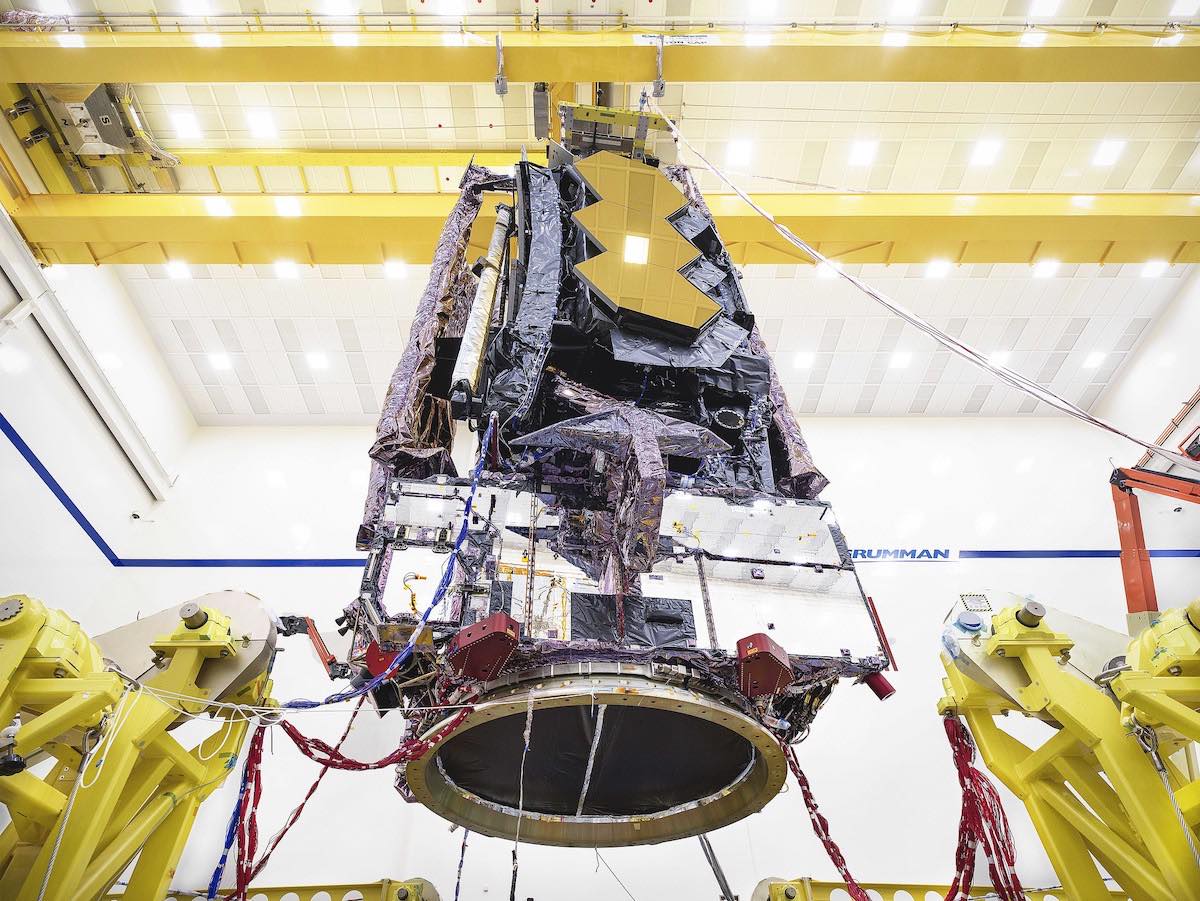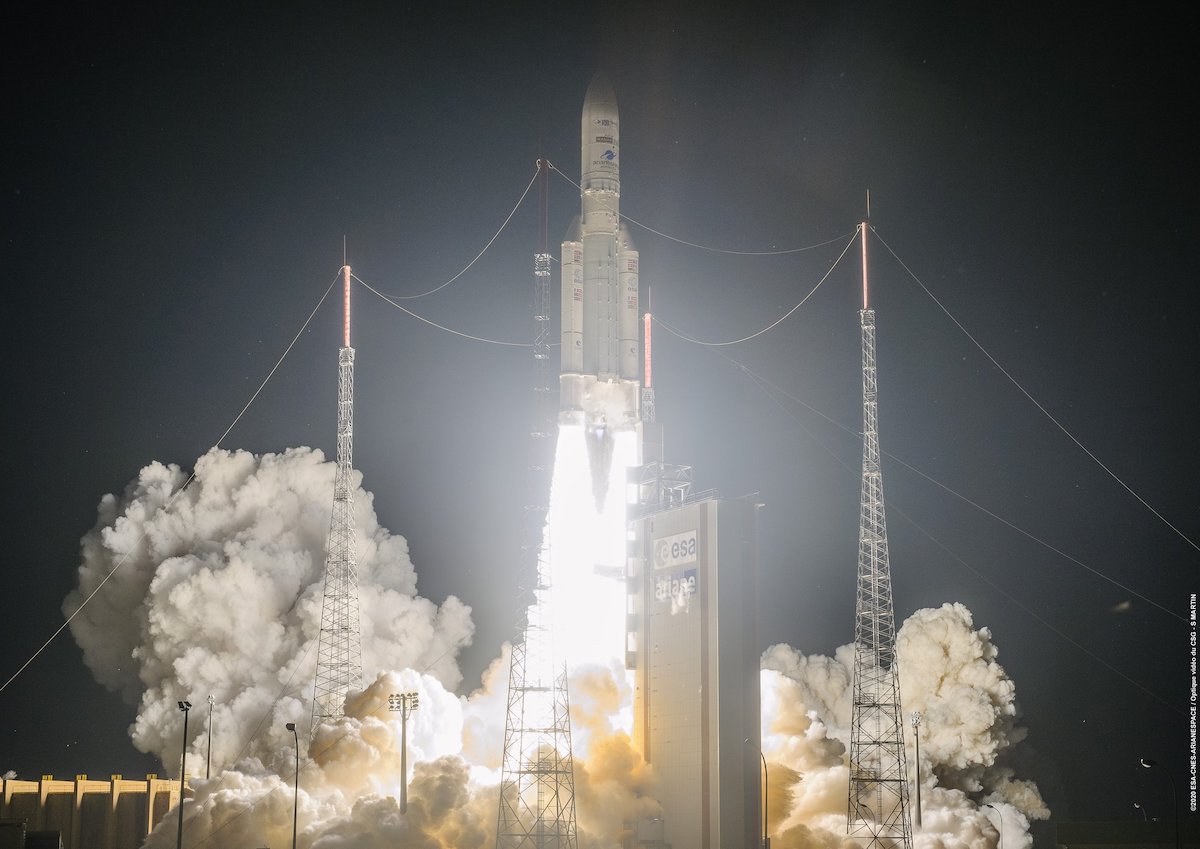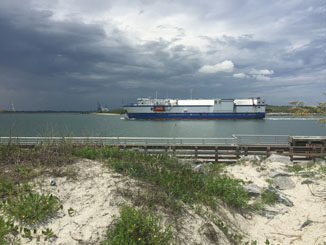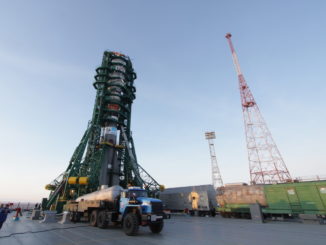
The fully-assembled James Webb Space Telescope has completed testing in Southern California to verify the $10 billion mission can withstand the sound and shaking it will see during launch scheduled late next year on a European Ariane 5 rocket.
“With completion of its environmental tests, #NASAWebb has hit a monumental milestone & has proven it can endure the deafening noise, jarring shakes & vibrations experienced during launch,” tweeted Thomas Zurbuchen, associate administrator of NASA’s science mission directorate.
The environmental testing at a Northrop Grumman facility in Redondo Beach, California, subjected the Webb observatory to the rigors of launch. Northrop Grumman and NASA teams first put the observatory through an acoustic test to simulate the sound energy it will see during launch.
Engineers blasted the observatory with high-frequency sound pressure levels above 140 decibels, “with a spectrum tuned to the specific signature of the Ariane 5 rocket it will ride to space.” Sensors inside the acoustic test chamber measured nearly 600 individual channels of motion data, roughly six times more than in a typical spacecraft acoustic and vibration test campaign.
“The complex size and shape of the observatory required considerably more measurement to ensure success,” NASA said in a statement.
Then engineers moved JWST — clad inside a mobile clean room to protect its sensitive mirrors, instruments, and other spacecraft systems — to a different facility on the Northrop Grumman factory and placed it on a vibration table. The table shook the observatory in vertical and horizontal axes to check its ability to weather the lower-frequency energy imparted during a rocket launch.

“Environmental testing demonstrates Webb’s ability to survive the rocket ride to space, which is the most violent portion of its trip to orbit approximately a million miles from Earth,” said Bill Ochs, Webb project manager at NASA’s Goddard Space Flight Center in Greenbelt, Maryland. “The multinational group of individuals responsible for the execution of the acoustic and vibration test is composed of an outstanding and dedicated group of folks who are typical of the entire Webb team.”
Individual elements of the spacecraft and the telescope had passed similar environment tests before, but the recent milestones marked the first time the entire observatory went through full-scale acoustic and vibration testing.
Segments of the observatory, such as its spacecraft platform and telescope, have also completed thermal vacuum testing to check their performance under the extreme temperature swings they will see in the airless environment of deep space.
In the months before starting the environmental tests, engineers completed a comprehensive systems test on Webb and a test of the mission’s ground infrastructure.
NASA and Northrop Grumman performed the environmental tests with Webb in its launch configuration, with its mirrors, sunshield and solar panels folded up as they will be positioned to fit inside the envelope of the Ariane 5 rocket.
In the coming months, engineers will deploy the observatory into its operational configuration to check that actuators and mechanisms are still in good shape after weathering the acoustic and vibration testing. The deployments will include opening Webb’s segmented 21.3-foot-diameter (6.5-meter), and unfurling the mission’s five-layer thermal sunshield to the size of a tennis court.
NASA officials said that a preliminary analysis of the recent environmental testing suggests the observatory passed the tests successfully. “But the full verification of flight worthiness will occur after Webb has successfully completed final deployment tests,” NASA said.
Ground crews will then fold up the observatory and place it in a special shipping container for transportation by sea to the European-run Guiana Space Center in South America. Teams there will ready Webb for launch on an Ariane 5 rocket, and the observatory will be in space the next time it unfurls its telescope wings, sunshield and other appendages.
NASA announced in July that the launch of JWST would be delayed to Oct. 31, 2021, a seven-month slip from its previous target launch date in March 2021. Officials blamed the coronavirus pandemic, which slowed testing at Northrop Grumman, and other technical issues for the delay.
Webb is the largest and most powerful space telescope ever built. The observatory’s infrared instruments will peer into the oldest, most distant reaches of the universe to study some of the first stars and galaxies that formed after the Big Bang more than 13.5 billion years ago.
Astronomers will also use Webb to look at how galaxies form and evolve, to study the birth of stars, and to learn more about the atmospheres of planets that may be hospitable for life outside our solar system.
The Ariane 5 launch is part of the European Space Agency’s contribution to the JWST mission, along with part of the observatory’s scientific payload. The Canadian Space Agency is also a partner on the mission with NASA and ESA.
ESA signed a launch contract with Arianespace to provide the Ariane 5 launch services for the JWST mission. The Ariane 5 will send the space telescope toward an observing post nearly a million miles (1.5 million kilometers) from Earth.

On the most recent Ariane 5 launch in August, engineers tested small modifications to the rocket’s payload fairing designed to meet the stringent requirements for the one-of-a-kind astronomical observatory.
Engineers changed the design of vents on the Ariane 5’s payload shroud — built by RUAG Space in Switzerland — to address a concern that a depressurization event could damage the Webb observatory when the fairing jettisons after liftoff. Officials were concerned residual air trapped in Webb’s folded sunshield membranes could cause an “over-stress condition” at the time of fairing separation.
In a recent interview, the director of ESA’s space transportation division said the space agency is committed to ensuring an Ariane 5 is ready to launch the Webb observatory. There are only eight Ariane 5 missions yet to fly before ESA and Arianespace fully transition to Europe’s next-generation Ariane 6 rocket, which is scheduled for an inaugural test launch in the second half of 2021.
“We are ready with Ariane 5 waiting for James Webb,” said Daniel Neuenschwander, ESA’s director of space transportation.
While European teams ready for the debut of the Ariane 6 rocket and continue introducing small upgrades to the Ariane 5, Neuenschwander said ESA is committed to using an Ariane 5 launcher with “fully qualified” components for the costly JWST mission.
“We will use what we have ready for James Webb,” he said. “I will only give my green light on any point which is fully qualified. If they (the JWST team) are ready, I am confident we will be ready, especially with the new date of October 2021.”
Email the author.
Follow Stephen Clark on Twitter: @StephenClark1.



